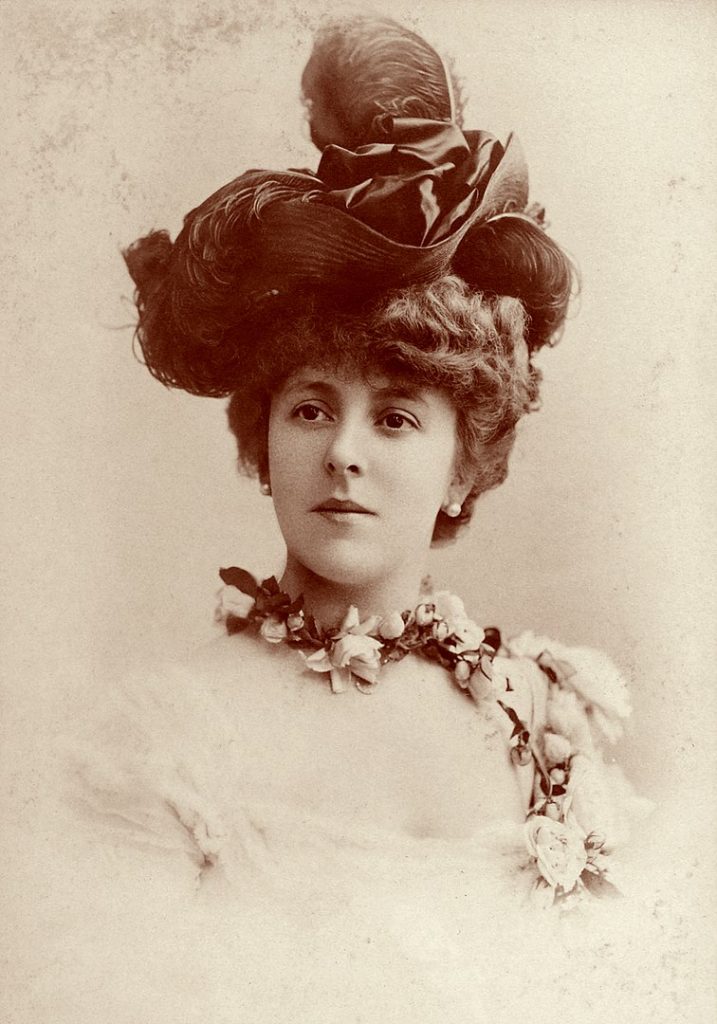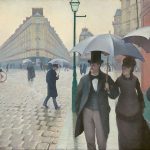
Émilienne d’Alençon was more than just a courtesan—she was a muse, a performer, and a living symbol of the decadence of the Belle Époque. As a dancer at the Folies Bergère, she captivated audiences, but it was her beauty and charm that made her a figure of fascination for artists, photographers, and writers. She moved among the cultural elite, inspiring painters and literary figures who sought to capture the essence of an era obsessed with glamour and sensuality.
During the late 19th and early 20th centuries, courtesans were not simply mistresses; they were tastemakers, influencing art, fashion, and social trends. Émilienne’s image—whether captured in photographs, paintings, or descriptions in novels—reflected the fantasies of the time. She lived a life of luxury, surrounded by aristocrats, artists, and intellectuals who saw her as a muse for their work.
The Belle Époque (1871–1914) was a period of extraordinary artistic and cultural growth, and Émilienne d’Alençon was at the heart of it. She was part of the world that inspired Henri de Toulouse-Lautrec, Jean Béraud, and countless photographers who documented the golden age of Parisian nightlife. While many courtesans of her time faded into obscurity, Émilienne’s likeness remains preserved in the visual and literary art of her era.
This article explores how Émilienne d’Alençon became a muse to some of the most celebrated artists of the Belle Époque. Through paintings, photographs, and literature, her influence can still be traced, offering a glimpse into the world she once ruled.
The Rise of Émilienne d’Alençon in Belle Époque Paris
Born in 1869, Émilienne d’Alençon emerged as one of the most recognizable courtesans and performers of the late 19th century. She first gained attention as a dancer at the Folies Bergère, one of Paris’s most famous cabarets, where her beauty and charisma quickly set her apart from the rest. At a time when dancers and courtesans often overlapped in society, her career as a performer helped propel her into the world of the Parisian elite.
Much like Liane de Pougy and La Belle Otero, two of her famous contemporaries, Émilienne cultivated an air of mystery and allure that attracted wealthy admirers. She counted King Leopold II of Belgium among her lovers, as well as a string of aristocrats, businessmen, and high-society figures who lavished her with wealth and gifts. These relationships not only secured her financial future but also expanded her influence, making her a sought-after figure in artistic and social circles.
Paris during the Belle Époque was a world where wealth and art intertwined, and courtesans often became symbols of both decadence and artistic inspiration. Émilienne was no exception—her beauty and fashionable presence made her an icon. Unlike many women of her time, she had agency over her image, controlling how she was seen in public and in artistic representations.
Her rise to fame was not just about beauty or wealth; it was about being at the right place at the right time, in a city where the arts were flourishing. Parisian painters and photographers needed subjects who embodied the spirit of the age, and Émilienne, with her refined yet scandalous reputation, fit the role perfectly.
The Courtesan as a Muse: Why Artists Were Drawn to Her
Artists of the Belle Époque were captivated by courtesans for a number of reasons. These women embodied the contradictions of the era—they were both admired and scandalized, celebrated and condemned. Their extravagant lifestyles and dramatic love affairs made them perfect subjects for paintings, novels, and photographs. Émilienne d’Alençon, in particular, fascinated artists because she represented the idealized Parisian femme fatale, a woman who was both unattainable and intimately familiar.
Courtesans had freedom and social mobility that respectable women of the time did not. While upper-class women were bound by strict social expectations, courtesans could move freely among artists, writers, and intellectuals. This gave them a unique role as both participants in and subjects of artistic movements. Émilienne was part of this world, frequenting the same cafés, salons, and theaters as the painters and poets who depicted her.
Another reason for her appeal as a muse was her ability to reinvent herself. Unlike static portraits of aristocratic women, who were often painted to show their lineage or status, courtesans could take on different personas. They could be glamorous, erotic, tragic, or mysterious, depending on how they wanted to be portrayed. This gave artists room for creative interpretation, making Émilienne and her peers fascinating subjects.
Her presence in paintings and photographs wasn’t just about capturing her beauty—it was about capturing the spirit of the age. She represented the decadence, sensuality, and fleeting nature of the Belle Époque, making her an ideal figure for artistic exploration.
Émilienne and the Influence of Toulouse-Lautrec
One of the most famous artists of the Belle Époque, Henri de Toulouse-Lautrec, was known for his portrayals of the Parisian demi-monde—the world of cabarets, dancers, and courtesans. While there is no confirmed painting of Émilienne by Toulouse-Lautrec, it is likely that she moved in the same circles as his other famous muses, such as Jane Avril and Yvette Guilbert.
Toulouse-Lautrec’s art captures the world Émilienne inhabited—the dimly lit theaters, the extravagant costumes, the carefree yet melancholic figures of the Parisian nightlife. Even if she wasn’t one of his direct subjects, she would have been part of the atmosphere he sought to portray. His famous paintings of Moulin Rouge performers reflect the energy and sensuality of the environment that Émilienne was a part of.
If Toulouse-Lautrec had painted her, he would likely have depicted her in his signature style—bold lines, exaggerated features, and a slightly melancholic air. His courtesans and dancers often appear as both icons of desire and figures of loneliness, a duality that would have suited Émilienne’s later life.
While her direct connection to Lautrec remains uncertain, his work stands as a testament to the world she influenced. His depictions of Parisian nightlife and courtesans provide a glimpse into the life she lived and the stage upon which she performed.
Photographic Portraits of Émilienne d’Alençon
Unlike many courtesans who were primarily immortalized in paintings, Émilienne d’Alençon was extensively photographed. Photography was becoming increasingly popular in the late 19th century, and Émilienne took full advantage of the medium to cultivate her image. Her portraits, often staged with elaborate gowns, jewelry, and dramatic poses, helped solidify her as a fashion icon and a living work of art.
These photographs were not just for private collections; many of them were reproduced as postcards and prints, allowing the public to admire her beauty. Some of the most famous photographers of the time captured her image, and these portraits were circulated widely, enhancing her fame. This widespread distribution of her likeness made her one of the most recognizable courtesans of the era.
In many of her photographs, she appears as the epitome of Belle Époque elegance—soft lighting, luxurious fabrics, and an air of mystery. Unlike aristocratic women, who were often photographed in rigid, conservative poses, Émilienne’s portraits embraced sensuality and theatricality.
Photography gave Émilienne a degree of control over how she was seen, a rare power for women of her time. By carefully curating her image, she ensured that she remained relevant and desirable, even as younger courtesans and performers entered the scene.
Did Émilienne Model for Jean Béraud?
Jean Béraud, one of the most celebrated painters of the Belle Époque, was known for his detailed and atmospheric depictions of Parisian life. His paintings often featured elegant women walking along the boulevards, attending the opera, or enjoying the nightlife of the city. Given that Béraud frequently painted the demimondaine society, it is possible that Émilienne d’Alençon either sat for him or inspired some of his works.
Béraud’s art captured the essence of Parisian high society and its courtesans, portraying them with a realism that stood in contrast to the more exaggerated styles of artists like Toulouse-Lautrec. Some of his works feature women who resemble Émilienne—blonde, impeccably dressed, and poised with an air of quiet confidence. However, unlike Lautrec, who often focused on the grittier aspects of nightlife, Béraud’s paintings had a refined and almost photographic quality.
If Émilienne was one of his subjects, his paintings would have emphasized her elegance rather than her role as a courtesan. Unlike other artists who depicted courtesans in moments of seduction or performance, Béraud painted them as part of Parisian society, walking along the Champs-Élysées or sitting in fashionable cafés. This distinction aligns with Émilienne’s cultivated public image—more of a fashionable socialite than an outright courtesan.
While there is no definitive record proving that she modeled for Béraud, his works remain an important artistic record of the world she inhabited. Whether or not she was directly painted by him, his art immortalizes the luxurious yet fleeting world that women like Émilienne represented.
Writers and Poets Inspired by Émilienne
Courtesans were not just muses for painters and photographers—they also influenced literature. Writers of the Belle Époque, fascinated by the glamour and tragedy of these women, often based characters on real-life figures. While Émilienne d’Alençon is not explicitly named as the inspiration for any major literary character, her lifestyle and public persona fit the mold of many fictional courtesans from the time.
One of the most famous writers of the era, Marcel Proust, frequently wrote about courtesans in his work. In À la recherche du temps perdu (In Search of Lost Time), Proust depicted the world of Parisian high society and its entanglements with courtesans. Many scholars believe that some of his fictional women—notably Odette de Crécy—were inspired by real-life courtesans like Émilienne, Liane de Pougy, and La Belle Otero.
The French writer Colette, herself once a performer in the Parisian theater scene, also chronicled the lives of courtesans and actresses. While Émilienne was not a confirmed subject of Colette’s work, the themes of reinvention, seduction, and fleeting fame that run through her novels strongly echo Émilienne’s own life. Colette’s courtesan characters were often women who used wit, charm, and beauty to navigate a world dominated by men, much like Émilienne herself.
Beyond literature, Émilienne’s presence in elite Parisian circles made her a figure of gossip and intrigue in the press. Newspapers and society columns regularly reported on her romances, fashion choices, and lavish lifestyle, contributing to the myth-making that surrounded her. This media fascination ensured that, even if she was not named outright in literary works, her legend endured through cultural memory and artistic inspiration.
The Decline of a Muse: Émilienne’s Later Years
Like many courtesans of her era, Émilienne’s reign at the top of Parisian society did not last forever. By the early 1910s, she began to fade from the spotlight as younger courtesans and performers took her place. The Belle Époque was an era of constant reinvention, and as new faces emerged, the once-revered icons of the past found themselves pushed aside.
As she aged, her finances also became uncertain. Courtesans who failed to secure long-term wealth through marriage or investments often found themselves in financial ruin once their beauty and influence waned. Some, like Liane de Pougy, retired into religious life, while others, like La Belle Otero, withdrew into obscurity. Émilienne, while never completely forgotten, struggled to maintain the lifestyle she had once enjoyed.
The outbreak of World War I in 1914 marked the definitive end of the Belle Époque. The war changed the cultural landscape of Europe, and the frivolous excesses of the past suddenly seemed out of place in a world grappling with devastation and loss. The glamorous world that had celebrated Émilienne and her contemporaries no longer existed, and many of the artists who had once painted and photographed her moved on to new subjects.
Émilienne lived well into the 20th century, passing away in 1946, long after her days as a muse had ended. Unlike some of her contemporaries, she did not leave behind memoirs or written accounts of her life, making much of her later years a mystery. However, the images and stories that remain ensure that she is still remembered as one of the defining figures of the Belle Époque.
Legacy: How Émilienne d’Alençon Shaped Art and Culture

Although her name may not be as well-known today as some of her contemporaries, Émilienne d’Alençon’s image and influence live on in the art and photography of the Belle Époque. The portraits, photographs, and possible paintings of her time preserve her beauty and allure, offering a glimpse into the world she once ruled.
She represents the intersection of art, beauty, and commerce—a woman who understood the power of her own image and used it to shape her destiny. Whether in photographs that showcased her in elegant gowns or in paintings that hinted at the mystique of Parisian nightlife, she remains a symbol of the era’s opulence. Courtesans like Émilienne were not just muses; they were active participants in their own legend, curating their public personas with as much precision as any modern celebrity.
Today, her legacy can still be traced in the lingering fascination with the Belle Époque, an era where art and life blurred together. The world she inhabited—the grand theaters, the salons filled with artists, the luxurious mansions of her wealthy lovers—has vanished, but the art that captured her spirit endures. Through paintings, photographs, and literature, Émilienne d’Alençon remains immortalized as one of the last great muses of a golden age.
Key Takeaways
- Émilienne d’Alençon was a courtesan, dancer, and muse who influenced the art and photography of the Belle Époque.
- She moved in elite artistic circles and was possibly depicted in paintings by Jean Béraud and other Parisian artists.
- Henri de Toulouse-Lautrec captured the world she lived in, even if no confirmed portrait of her exists.
- She was extensively photographed, using the medium to cultivate her public image and maintain her status.
- Though she faded from fame, her influence remains in art, literature, and cultural history, representing the excess and beauty of a bygone era.
FAQs
Was Émilienne d’Alençon painted by Toulouse-Lautrec?
There is no confirmed painting of her by Lautrec, but she lived in the same circles he depicted in his famous cabaret paintings.
Did Émilienne d’Alençon model for Jean Béraud?
There is no definitive proof, but Béraud’s paintings often featured women who looked like her and lived the same luxurious lifestyle.
Why were courtesans like Émilienne popular muses?
Courtesans embodied beauty, sensuality, and social freedom, making them ideal subjects for artists seeking to capture the spirit of the Belle Époque.
How was Émilienne’s image preserved?
She was extensively photographed, and her portraits were reproduced in postcards, making her widely recognized in her time.
What happened to her in later life?
She faded from public view after the Belle Époque ended and died in 1946, long after her days as a celebrated muse.




